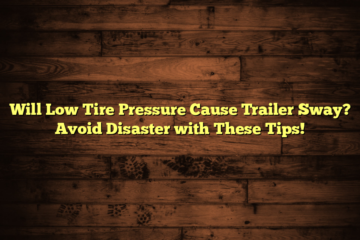What is the Recommended Tire Pressure for 80 PSI Max?
Maintaining the correct tire pressure is crucial for ensuring optimal safety and performance of your vehicle. In this article, we will explore the recommended tire pressure for tires with a maximum pressure of 80 PSI. We will also discuss the importance of tire pressure, how to find the recommended pressure, factors that affect tire pressure, and tips for maintaining the right tire pressure.
Key Takeaways
- Underinflated tires can lead to reduced fuel efficiency, poor handling, and increased risk of tire failure.
- Overinflated tires can cause a harsh ride, uneven tire wear, and decreased traction.
- The maximum tire pressure rating of 80 PSI indicates the maximum safe pressure the tire can handle.
- To find the recommended tire pressure, refer to the vehicle’s owner’s manual or the tire placard located on the driver’s side door jamb.
- Temperature fluctuations can cause tire pressure to change, so it’s important to regularly check and adjust tire pressure.
Why Tire Pressure Matters

The Dangers of Underinflated Tires
Underinflated tires can have serious consequences for both your vehicle and your safety. When your tires are not properly inflated, it affects the overall performance of your vehicle. Low tire pressure can lead to decreased fuel efficiency, as the engine has to work harder to move the car. This means you’ll be spending more money on gas and emitting more exhaust fumes into the environment.
Additionally, underinflated tires can affect your vehicle’s handling and braking capabilities. It can cause the tires to wear unevenly, leading to a shorter lifespan and the need for more frequent replacements. Tire blowouts are also more likely to occur when the tire pressure is too low, which can be extremely dangerous, especially at high speeds.
To avoid these risks, it’s important to regularly check and maintain the proper tire pressure. This can be done easily with a tire pressure gauge, which can be purchased at most auto supply stores. By keeping your tires properly inflated, you’ll not only improve your vehicle’s performance but also ensure your safety on the road.
The Risks of Overinflated Tires
Over-inflating tires can have serious consequences. When tires are inflated to a pressure higher than recommended, it can lead to decreased traction and faster wear. This not only affects the performance of the tires but also compromises the safety of drivers and passengers.
Over-inflated tires are more prone to blowouts and can increase the risk of accidents. It’s important to always check and maintain the proper tire pressure to ensure optimal performance and safety on the road.
Understanding Tire Pressure Ratings
What Does 80 PSI Max Mean?
When you see a tire pressure rating of 80 PSI max, it means that the tire is designed to handle a maximum pressure of 80 pounds per square inch. This rating is important because it ensures that the tire can safely support the weight of the vehicle and provide optimal performance.
It’s crucial to note that exceeding the maximum tire pressure can be dangerous. Overinflated tires can lead to a harsh and uncomfortable ride, reduced traction, and increased risk of tire damage or blowouts. Therefore, it’s essential to always follow the manufacturer’s recommended tire pressure for your specific vehicle.
To find the recommended tire pressure, you can refer to your vehicle’s owner’s manual or the tire placard located on the driver’s side door jamb or inside the fuel door. These sources will provide you with the correct tire pressure for both the front and rear tires.
Remember, maintaining the right tire pressure is not only crucial for your safety but also for the longevity of your tires and fuel efficiency. So, make it a habit to check your tire pressure regularly and adjust it as needed.
How to Find the Recommended Tire Pressure
Finding the recommended tire pressure for your vehicle is crucial for maintaining optimal performance and safety. It ensures that your tires wear evenly, improves fuel efficiency, and reduces the risk of accidents. So, how do you find the right tire pressure?
One way is to check your vehicle’s owner’s manual. It provides valuable information about the recommended tire pressure specific to your make and model. Another option is to look for a sticker on the driver’s side door jamb or inside the fuel door. This sticker usually displays the recommended tire pressure for both the front and rear tires.
If you can’t find the information in these places, you can also visit the manufacturer’s website or contact their customer service for assistance. They will be able to provide you with the accurate tire pressure for your vehicle.
Remember, it’s important to check and adjust your tire pressure regularly to ensure optimal performance and safety on the road.
Factors Affecting Tire Pressure

Temperature’s Impact on Tire Pressure
The temperature plays a crucial role in determining the tire pressure. When the air temperature drops, the tire pressure decreases as well. This is because cold air is denser, causing the molecules to have less energy. As a result, the air inside the tires contracts, leading to a decrease in tire pressure.
It’s important to note that even a slight drop in temperature can have a noticeable impact on tire pressure. For every 10-degree Fahrenheit decrease in temperature, the tire pressure can decrease by about 1-2 psi.
To ensure optimal tire performance and safety, it’s recommended to regularly check and adjust the tire pressure, especially during colder months. This can be done using a tire pressure gauge, which can be purchased at most automotive stores or online.
Remember, maintaining the right tire pressure is essential for proper handling, fuel efficiency, and tire longevity.
The Importance of Regular Tire Checks
Regular tire checks are a simple yet effective way to ensure your safety while driving. It’s essential to monitor your tire’s tread depth, replace them when necessary, and maintain the recommended tire pressure. By regularly inspecting your tires, you can identify any signs of wear and tear, such as uneven tread wear or bulges, which can indicate potential tire failure.
Additionally, checking your tire pressure regularly helps to optimize fuel efficiency and extend the lifespan of your tires. Remember, proper tire maintenance is crucial for a smooth and safe driving experience.
Maintaining the Right Tire Pressure

How to Properly Inflate Your Tires
Properly inflating your tires is essential for optimal performance and safety on the road. When your tires are inflated to the correct pressure, they respond better to turns, stops, and road conditions. This not only improves your vehicle’s handling but also prevents unnecessary wear and tear on your tires.
To ensure you are inflating your tires correctly, follow these simple steps:
- Check the recommended tire pressure: Refer to your vehicle’s owner’s manual or the sticker on the driver’s side door jamb to find the recommended tire pressure. This information is specific to your vehicle and takes into account factors such as the weight of the vehicle and the type of tires.
- Use a reliable tire pressure gauge: Invest in a good quality tire pressure gauge to accurately measure the pressure in your tires. Digital gauges are easy to read and provide precise measurements.
- Inflate the tires: If the pressure is below the recommended level, use an air compressor to add air to the tires. Start by removing the valve cap and attach the air hose securely to the valve stem. Add air in short bursts, checking the pressure frequently to avoid overinflating.
- Check the pressure again: After inflating the tires, use the tire pressure gauge to check the pressure once more. Make sure it matches the recommended level.
- Repeat regularly: Tire pressure can fluctuate over time, so it’s important to check and adjust it regularly. Aim to check your tire pressure at least once a month and before long trips.
By following these steps, you can ensure that your tires are properly inflated, promoting better performance, fuel efficiency, and overall safety on the road.
When to Check and Adjust Tire Pressure
It’s important to regularly check and adjust your tire pressure to ensure optimal performance and safety. Here are some key times when you should check and adjust your tire pressure:
- Before a Long Trip: Before hitting the road for a long journey, take a few minutes to check your tire pressure. This will help prevent any unexpected issues and ensure a smooth and comfortable ride.
- Seasonal Changes: As the seasons change, so does the air pressure in your tires. Cold weather can cause tire pressure to drop, while hot weather can cause it to increase. Make it a habit to check your tire pressure at the start of each season.
- After a Drastic Temperature Change: If you experience a sudden change in temperature, such as going from a cold climate to a warm one, or vice versa, it’s a good idea to check your tire pressure. Temperature fluctuations can affect tire pressure, so it’s important to make sure it’s at the recommended level.
Remember, maintaining the right tire pressure is essential for optimal performance, fuel efficiency, and safety on the road.
Conclusion
In conclusion, it is important to maintain the recommended tire pressure for your vehicle’s maximum PSI of 80. This ensures optimal performance, fuel efficiency, and safety on the road. Remember to regularly check and adjust your tire pressure to avoid any potential issues. Safe travels!
Frequently Asked Questions
What happens if my tires are underinflated?
Underinflated tires can lead to poor fuel efficiency, reduced tire life, and increased risk of tire blowouts.
Can overinflated tires cause damage?
Yes, overinflated tires can cause uneven tire wear, reduced traction, and a harsher ride.
How often should I check my tire pressure?
It is recommended to check your tire pressure at least once a month and before long trips.
What is the correct tire pressure for my vehicle?
The recommended tire pressure can usually be found in your vehicle’s owner’s manual or on a sticker inside the driver’s door jamb.
Does tire pressure change with temperature?
Yes, tire pressure can increase or decrease with temperature changes. It is important to check and adjust tire pressure accordingly.
Can I use the maximum tire pressure listed on the sidewall?
No, the maximum tire pressure listed on the sidewall is not the recommended pressure for normal driving. It is best to follow the manufacturer’s recommended tire pressure.




